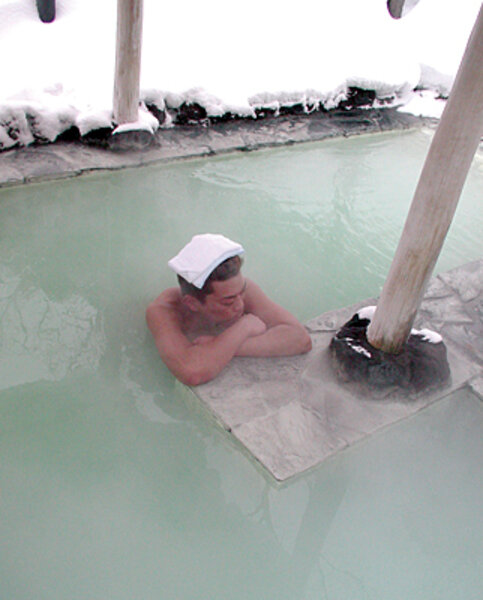Japan's nuclear dilemma: Is geothermal the answer?
Loading...
| Tsuchiyu, Japan
Walking through Tsuchiyu's near-deserted streets on a rainy weekday afternoon, it's hard to imagine that this spa town of 450 could become a standard-bearer in Japan's quest to wean itself off nuclear power.
Until recently, onsen (hot spring) operators were vocal opponents of geothermal power, which, along with other forms of renewable energy, is being considered as a serious alternative to nuclear power: Geothermal plants, they had once feared, would affect the level and quality of water that draws millions of Japanese to onsen resorts every year.
But then came the meltdown at the Fukushima Daiichi nuclear power plant – and renewed attention to long-neglected geothermal power as a potential solution to Japan's energy conundrum. And onsen operators – a key constituency for the tourism they drive – are slowly coming on board.
Located nine miles southwest of Fukushima city, Tsuchiyu is launching a bold test in harnessing the potential of Japan's huge subterranean reserves of volcanic water.
By spring 2014, Tsuchiyu hopes to be generating 250 kilowatts of electricity – about a quarter of its total needs – at a new geothermal plant located on its outskirts.
Japan's energy policy, announced after two months of consultations with the public, calls for renewables to make up about 30 percent of Japan's future energy mix – an eightfold rise from 2010 levels.
The plan will see new investment in renewables totaling about $476 billion over the next 20 years. In the short term, however, Japan will continue to import record quantities of fossil fuels to fill the gap.
Encouraged to invest in renewable
Businesses, meanwhile, have been encouraged to invest by a new tariff that will enable them to sell electricity from renewable sources to utilities at above-market prices.
Marubeni Corp. is about to begin building Japan's largest solar energy complex, in Oita Prefecture. After it's completed in early 2014, its 350,000 solar panels will be capable of generating more than 81,000 kilowatts – enough electricity for 30,000 households.
Sumitomo Corp. is to add wind farms and biomass plants to its energy inventory, and expects profits from wind alone to triple in the next three years.
Until recently, Japan's development of geothermal was mainly hindered by a ban on building plants in national parks, where some 80 percent of potential sites are located. But the government decided to relax the ban in five areas after the Fukushima accident.
Read the Monitor's Focus story on Japan's nuclear waste
In addition to the tariffs, the Ministry of Economy, Trade and Industry has earmarked about $29 million in subsidies for the next year to encourage communities and private investors to develop geothermal sources. Most of the money will be used to guarantee loans and fund research and drilling.
Theoretically, geothermal could produce 24 million kilowatts of electricity here – making Japan the country with the third-biggest output in the world after the United States and Indonesia.
Plans for geothermal
Now, Japan's 18 geothermal plants account for just 0.2 percent – or 537,000 kilowatts of installed capacity – of the total energy share, according to the trade and industry ministry. No plants with a capacity of more than 10,000 kilowatts have been built for 16 years.
Environment Minister Goshi Hosono said Japan planned to increase geothermal's share to 3.88 million kilowatts by around 2030.
Experts say that target is ambitious, but achievable. "Considering various bottlenecks and difficulties and long lead time, reaching that number by 2030 will require a massive effort by regulators and developers, but it is not impossible," says Emi Mizuno, of the Japan Renewable Energy Foundation.
Ms. Mizuno also notes that previous geothermal plants in Japan have not caused hot springs to dry up. "The current geothermal plants in Japan have never caused the problems that onsen communities are worried about, such as the changes in onsen quality and quantity and/or pollution," she says.
In Tsuchiyu, profits from the venture will be used to repair and replace hotels that were damaged or destroyed in the earthquake. "The facility will be very unobtrusive, says Kazuya Ikeda, manager of the Tsuchiyu onsen tourist association, adding that "there will be a limited effect on the environment."
And if the geothermal experiment works, it should allay anxiety in other onsen towns. Eventually, the facility will meet just about all of the town's energy needs.
"The fact that the Tsuchiyu project is located in Fukushima has a significant symbolic meaning," says Mizuno.







